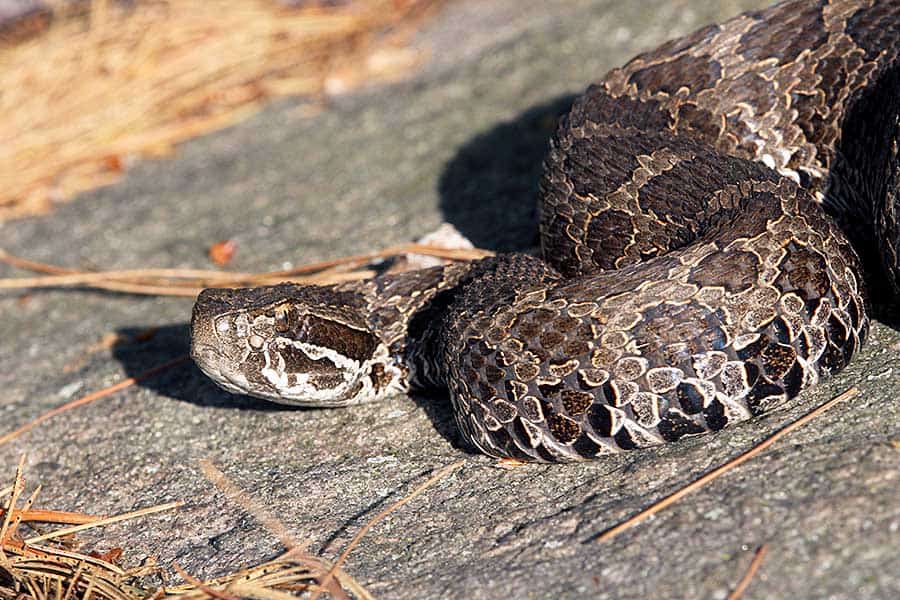
The beautiful state of Pennsylvania, renowned for its lush forests and diverse wildlife, is a natural paradise that sparks curiosity about its inhabitants. Among the various creatures that call this region home, snakes hold a unique fascination for many.
As you venture into the state’s picturesque landscapes, you might wonder: Does Pennsylvania have venomous snakes? In this informative post, we’ll uncover the facts about the venomous snake population in the Keystone State and reveal which potentially dangerous species can be found there.
The Venomous Side of Pennsylvania
In Pennsylvania, numerous snake species can be found, 21 in fact, with the majority being harmless and serving crucial functions in the ecosystem. Nevertheless, it is imperative to distinguish between venomous and nonvenomous in order to maintain safety and eliminate any confusion.
Pennsylvania has three venomous species native to the state: the timber rattlesnake, the northern copperhead, and the eastern massasauga, although most species in the state pose no threat.
Timber Rattlesnake

The timber rattlesnake (Crotalus horridus) is a venomous species native to the state. This captivating reptile can be found in various habitats, such as deciduous forests, mixed woodlands, and areas with rocky terrain, which offer perfect spots for hiding and basking.
They have a distinctive appearance, characterized by a pattern of dark cross bands on their backs on a lighter background that ranges from yellow to brown or even gray. They range from 30 to 60 inches long. Their most notable feature is the rattle at the end of their tail, which they use as a warning signal when feeling threatened.
Timber rattlesnakes play a vital role in the ecosystem by controlling rodent populations, primarily feeding on small mammals such as mice, squirrels, and chipmunks. They are ambush predators, relying on their excellent camouflage to remain undetected while waiting for prey to pass by. Once their target is within striking distance, they deliver a quick venomous bite to subdue their meal.
Although timber rattlesnakes are venomous, they are generally not aggressive toward humans unless provoked or cornered. In fact, they often prefer to remain hidden or retreat when encountered. However, giving them space and respecting their presence in the wild is crucial. If bitten, it is essential to seek immediate medical attention, as their venom can be potent and cause severe reactions.
In Pennsylvania, the range of the timber rattlesnake spans across the state but is more concentrated in the central and northern regions. They can be found in the Appalachian Mountains, the Allegheny Plateau, and the Pocono Mountains.
The timber rattlesnake holds a protected status in Pennsylvania. Engaging in activities such as killing, injuring, or harassing them without proper authorization is forbidden.
It is considered a species of special concern due to habitat loss and human persecution. Conservation measures have been implemented to protect this remarkable species and preserve its essential role in the state’s ecology. Efforts include habitat restoration, public education, and population monitoring to ensure long-term survival.
Northern Copperhead

The northern copperhead (Agkistrodon contortrix) is another venomous snake species found in Pennsylvania. This striking reptile prefers a variety of habitats, including deciduous forests, rocky outcrops, and river valleys. It is particularly fond of areas with plenty of cover, such as leaf litter, logs, and rock crevices.
The northern copperhead can be easily identified by its distinctive copper-colored head and hourglass-shaped markings along its body. The coloration varies from reddish-brown to a more golden hue, which allows it to blend seamlessly into its surroundings.
They play an important ecological role by controlling populations of small mammals and amphibians. They also are ambush predators, relying on their camouflage to remain concealed while waiting for prey to venture close enough to strike.
Although venomous, northern copperheads are not usually aggressive toward humans and will often retreat or freeze in place when encountered. However, it is vital to give them space and avoid accidentally stepping on or provoking them. In the event of a bite, seeking prompt medical attention is crucial, as their venom can cause pain, swelling, and, in rare cases, more severe complications.
In Pennsylvania, the range of the northern copperhead is primarily concentrated in the southern and central regions of the state. They can be found in the Appalachian Mountains, the Susquehanna River Valley, and the Allegheny Plateau.
According to The Pennsylvania Fish and Boat Commission, it is found in all but the upper portions of the northern tier counties and the extreme northwestern counties. While not considered endangered, the northern copperhead faces habitat loss and human persecution threats.
Conservation efforts to protect the northern copperhead include:
- Habitat preservation.
- Public education about the species.
- Monitoring programs to track population trends.
By understanding and respecting their vital role in the ecosystem, we can help ensure their continued survival in the wild.
Keystone Answers Fun Fact: The northern copperhead is the most common venomous snake in the Keystone State, and they are found in a variety of habitats.
Eastern Massasauga

The eastern massasauga (Sistrurus catenatus), a venomous rattlesnake species, can also be found in Pennsylvania. This elusive reptile inhabits various habitats, including wetlands, grasslands, and mixed woodlands with open clearings. They are particularly drawn to areas with a combination of wet and dry environments, such as marshes and adjacent uplands.
Eastern massasaugas are distinguishable by their thick bodies and relatively small size, usually ranging from 18 to 30 inches long. They exhibit a pattern of light and dark blotches on their back and smaller spots on their sides, with the coloration varying from gray to light brown. Like other rattlesnakes, they have a rattle at the end of their tail, which they use as a warning signal when disturbed.
Like the previous two species, they also play an essential role in controlling populations of small mammals and amphibians. They are ambush predators, using their superb camouflage to remain concealed while waiting for prey.
Although eastern massasaugas are venomous, they are generally not aggressive toward humans and would rather avoid confrontation. It is essential to give them space and respect their presence in the wild if encountered. If bitten, seeking immediate medical attention is necessary, as their venom can cause localized pain, swelling and could even cause more severe complications.
In Pennsylvania, the range of the eastern massasauga is limited to a few counties in the western portion of the state, such as Butler and Venango counties. They have experienced a significant decline in population due to habitat loss, human persecution, and fragmentation, resulting in their classification as a threatened species under the Endangered Species Act.
Conservation efforts to protect the eastern massasauga include:
- Habitat restoration and preservation.
- Public education about the importance of the species.
- Monitoring programs to assess population trends.
By recognizing and valuing these snakes’ role in the ecosystem, we can contribute to their continued existence in the wild.

Snake Safety Tips
Coming across venomous snakes might be unsettling, but it’s important to note that they generally evade human encounters. They have a significant role in the ecosystem, as they help regulate rodent populations and preserve the fragile equilibrium of nature.
In order to maintain personal safety when venturing into PA’s wilderness, it is recommended to follow these guidelines:
- Educate yourself: Get to know the appearance and behavior of venomous snakes found in Pennsylvania. Identifying them from a safe distance can help prevent unexpected encounters.
- Keep a safe distance: If you encounter one, especially if you believe it could be venomous, keep a respectful distance and let it move away independently. Refrain from attempting to touch or aggravate it.
- Wear appropriate attire: While exploring snake-inhabited areas, wear closed-toe footwear, long trousers, and think about using snake-resistant boots or gaiters for extra safety.
- Remain calm: If a snakebite occurs, remain as calm as possible and promptly seek medical help. The majority of bites can be averted, and the effects of snake venom differ, making expert assessment vital.
Slithering Away
Pennsylvania boasts a diverse array of species and hosts several venomous snakes. The timber rattlesnake, northern copperhead, and eastern massasauga reside within the state; however, it’s crucial to note that most snakes in the Commonwealth pose no threat and play a part in maintaining the ecosystem’s balance.
By respecting their environments and adhering to safety measures, humans and snakes can coexist peacefully, enabling everyone to enjoy Pennsylvania’s remarkable wild spaces.





